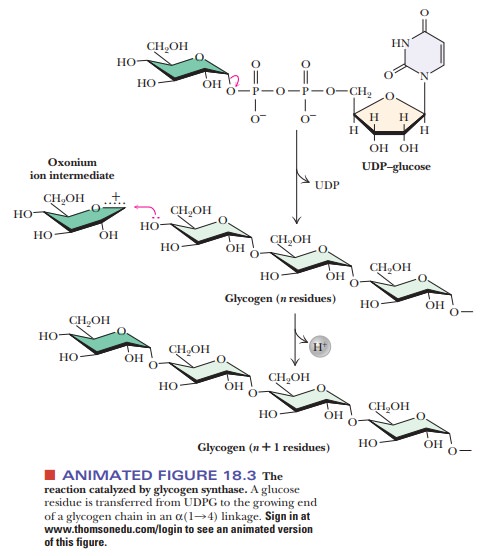Chapter: Biochemistry: Storage Mechanisms and Control in Carbohydrate Metabolism
How is glycogen formed from glucose?
How is glycogen formed from
glucose?
The formation of glycogen from glucose is not the exact reversal of
the breakdown of glycogen to glucose. The synthesis of glycogen requires
energy, which is provided by the hydrolysis of a nucleoside triphosphate, UTP.
In the first stage of glycogen synthesis, glucose-1-phosphate (obtained from
glucose-6-phosphate by an isomerization reaction) reacts with UTP to produce
uridine diphosphate glucose (also called UDP-glucose or UDPG) and pyrophosphate
(PPi).

The enzyme that catalyzes this reaction is UDP-glucose pyrophosphorylase. The exchange of one phosphoric
anhydride bond for another has a free-energy change close to zero. The release
of energy comes about when the enzyme inorganic pyrophosphatase catalyzes the
hydrolysis of pyrophosphate to two phosphates, a strongly exergonic reaction.
It is common in biochemistry to see the energy released by the
hydrolysis of pyrophosphate combined with the free energy of hydrolysis of a
nucleoside triphosphate. The coupling of these two exergonic reactions to a
reaction that is not energetically favorable allows an otherwise endergonic
reaction to take place. The supply of UTP is replenished by an exchange
reaction with ATP, which is catalyzed by nucleoside phosphate kinase:
UDP + ATP < - - - > UTP + ADP
This exchange reaction makes the hydrolysis of any nucleoside
triphosphate energetically equivalent to the hydrolysis of ATP.
The addition of UDPG to a growing chain of glycogen is the next step in glycogen synthesis. Each step involves formation of a new α(1 - > 4) glycosidic bond in a reaction catalyzed by the enzyme glycogen synthase (Figure 18.3). This enzyme cannot simply form a bond between two isolated glucose mol-ecules; it must add to an existing chain with α(1 - > 4) glycosidic linkages. The initiation of glycogen synthesis requires a primer for this reason. The hydroxyl group of a specific tyrosine of the protein glycogenin (37,300 Da) serves this purpose. In the first stage of glycogen synthesis, a glucose residue is linked to this tyrosine hydroxyl, and glucose residues are successively added to this first one. The glycogenin molecule itself acts as the catalyst for addition of glucoses until there are about eight of them linked together. At that point, glycogen synthase takes over.


Synthesis of glycogen requires the formation of α(1 - > 6) as well as α(1 - > 4) glycosidic linkages. A branching enzyme accomplishes this task. It does so by transferring a segment about 7 residues long from the end of a growing chain to a branch point where it catalyzes the formation of the required α(1 - > 6) glycosidic linkage (Figure 18.4).

Note that this enzyme has already
catalyzed the breaking of an α(1 - > 4) glycosidic linkage in the process
of transferring the oligosaccharide segment. Each transferred segment must come
from a chain at least 11 residues long; each new branch point must be at least
4 residues away from the nearest existing branch point.
Related Topics